On August 16, the Clayton Brothers opened their first solo exhibition at Mark Moore Gallery, titled "Open to the Public". Before the opening, the collaborative duo gave an informal talk moderated by critic Shana Nys Dambrot and Aaron Smith, associate chair of Art Center College of Design, where he and the Claytons earned their BFAs. Dambrot began the lecture by relating an anecdote in which she referred to Smith as "the third Clayton brother," as he is a close friend of the brothers, and once shared a studio with one of them. (Superficially, he also resembles them in manner and style so much that he appears to be related.) At that time, the brothers worked separately; it was not until 1998 or 1999 that they began collaborating. As Dambrot and Smith have both known the Claytons for many years, they knew what questions to ask in order to elicit the otherwise reticent artists to discuss their ideas and influences.
The entire show was inspired by Sun Thrift, a thrift store in Sunland near their studio. The Claytons first went to the store about three or four years ago. Amazed by the people and objects they would find there, they eventually came to visit the store about three times a week, documenting their forays by recording videos, taking photographs, and accumulating miscellaneous items.
Rob said that this was the most difficult show that they had ever installed, because there were so many pieces to display, and they wanted the overall exhibition to "support the energy of the thrift store." They succeeded remarkably. Entering a large thrift store is exciting yet overwhelming; one never knows what one might find, but there are so many items to look over. In "Open to the Public," the Claytons captured this overwhelming sense of stimulation, channeling it into the gallery space through ingenious installation design and sheer quantity of work.
Throughout the main gallery, eccentric tableaux and assemblages of found objects are interspersed with two-dimensional works, most of which are displayed in unorthodox ways that heighten their thrift-store-find sensibility. Drawings and cutouts are encased in vitrine-like frames, often accompanied by ironic artifacts such as price tags. Some of these frames are hung next to each other with no space between, in groups forming irregular shapes. Others are attached to poles on the floor as if they were children's writing desks or informative placards. The motley arrangements of artworks affect an impression of serendipity within contained randomness, similar to second-hand store merchandising.
![2014-08-19-Install8.jpg]()
Installation shot, "Open to the Public." Image courtesy of Mark Moore Gallery.
The exhibition's color scheme is gaudy and disjunctive like the colors of a thrift store's multiplicity of objects. The Claytons' palette is skillfully mismatched in a tongue-in-cheek nod to the untrained chromatic discord of paintings found in secondhand stores. Even the gallery walls, frames, and pedestals are painted in off-key chintzy colors whose disharmony is strangely charismatic.
The Claytons' clashing colors are paralleled by incongruities of form that speak of the disjointed relationships between objects' previous and future owners, as well as the inevitable incoherence involved in thrift store scavenging: things are imperfect, shopworn; pieces are missing from sets that should be matched.
The brothers' subject matter dovetails into two foci: the patrons of Sun Thrift, and the objects within. In the Claytons' work, people are objectified and objects are personified. This is particularly apparent in the exhibition's flagship painting titled "Open to the Public." In this piece, an inchoate woman and man survey items for purchase. Both figures are unclothed, as if they had started their shopping spree with literally nothing. The woman holds up her own legs as if they were a pair of pants. Her eyes are bloodshot, her hair stringy and blue like a vinyl doll's. The man's violet eyes are desperate, yet his smiling blue mouth seems kind. The figures stand in an ambiguous space that, paradoxically, also appears to be a shelf off of which they are pulling items. Both figures' feet and ankles, especially the man's, diverge slightly with their upper legs at the point where the floor/shelf meets the background. Perhaps the figures are trying on different personalities, searching for objects that might ameliorate or augment their personae. In so doing, they become objectified for visual consumption, fractured under the potentially harsh gaze of others.
![2014-08-19-OpenToThePublic_Painting.jpg]()
Clayton Brothers, "Open to the Public," 2014. Mixed media on canvas, 95 x 78 inches. Image courtesy of Mark Moore Gallery.
In "Sunday Sale," an elongated woman with weirdly shaped legs and pink and yellow fingernails holds an armful of flowers. A coat hanger hangs from her right hand. She has one shoe on and one off. Her figure is composed of three drawings, each inside a differently colored frame, stacked on top of one another in an off-kilter shape, like a tower of blocks about to topple over. Herself an agglomerate of three disparate identities, she wears a hat composed of a bundle of faces that might symbolize parts of her own personality, or people who owned the hat before her.
![2014-08-19-SUNDAY_SALE_1_2_3_Email0.jpg]()
Clayton Brothers, "Sunday Sale," 2014. Mixed media on paper, 128 x 148 inches. Image courtesy of Mark Moore Gallery.
The idea of multiple personalities within a single person, as seen in "Sunday Sale," or people experimenting with identity, as in "Open to the Public," is a common thread in many of the Claytons' works. In buying an object second-hand, one gives it a new life; but from it, one may also receive a new life. Acquiring a certain important item, or even a seemingly unimportant one such as an article of clothing, and integrating it into one's life can influence one's way of thinking or personal direction. Obviously, thrift stores provide the impoverished with affordable necessities and even luxuries. For anyone, rich or poor, shopping at thrift stores can increase one's disposable income, allowing one to purchase and discard items more freely and at a faster rate than buying them new, thereby allowing more experimentation with outward manifestations of one's identity. At the same time, each item's provenance may consist of a long string of previous owners, each of which left invisible traces of use.
During their talk, the brothers mentioned their special interest in paintings that they found at Sun Thrift. In fact, Rob said, their primary interest is not so much in the store itself as in the broken narratives and aborted creativity that it contains. They think of unfinished paintings they found as "discarded creative efforts," which they seek to resuscitate by appropriating them into their own art.
"We think about it as this continuation that we were playing with, helping these objects or these people try to continue their language out to the art world, in a way," said Rob.
The Claytons see their own dichotomous collaboration with each other as corresponding to a communal collaboration among: the two of them, the artists that created the paintings that inspired them, and the total environment that is Sun Thrift and its patrons. However, their two-dimensional works are so unmistakably the Claytons' own creations that it's hard to see the communal influences or continued language within their paintings or drawings.
In their paintings, the Claytons project their own fantasies and ideas onto people and objects that they saw in the thrift store. The people and objects are thus seen only through the artists' eyes and hands, turning them into a cast of characters whose individuality has been displaced by that of the artists. Real collaboration between the Claytons and the personalities and objects that inspired them is more apparent in their assemblages, where their creativity and technical skill are no less evident, but strikingly underscored by intertwinement with actual articles from the store.
![2014-08-19-SIDE_TABLE0.jpg]()
Clayton Brothers, "My Little Darling," 2014. Mixed media assemblage with mixed media on canvas, 44 x 16 x 20 inches. Image courtesy of Mark Moore Gallery. This assemblage, which merges found objects with the Claytons' own drawing, is particularly evocative.
Collaboration and continuation of broken narratives are most evident in the "Project Room," one of the most intriguing parts of the exhibition. The artists have turned the gallery's smaller room into an experimental, studio-like space that they plan to rearrange throughout the course of the exhibition in homage to the thrift store's constant state of flux. Rather than observing and recording, here the artists are actually accumulating things and actively putting them together like the other thrift store patrons. This room embodies the artists' ideas in their rawest form; here the brothers' personalities are most evident.
The centerpiece of the Project Room is a video projected onto the back of a shelf attached to a chair with a pole. At times, the video evokes a sense of creepiness, at times pathos, and occasionally a wry sense of humor augmented by clown music or funeral dirge soundtrack. Some of the scenes were shot with a camera inside a cart, moving very slowly down aisles. Others depict objects, store patrons reading, or children playing in the toy section. Behind the video, inside the shelf are cutouts and photos and plastic fruits. At the time of the opening, on the walls of the Project Room were various raw sources of inspiration such as dirty blank canvases, children's drawings, and black and white photos of signs seen at the store. In a particularly striking assemblage, a crutch holds up a shelf with an assortment of pathos-eliciting objects including a vase with dried flowers.
![2014-08-19-Thirft_Video_copy0.jpg]()
Clayton Brothers, "Dream," 2014. Video with memorabilia, 16 minutes, 7 seconds. Image courtesy of Mark Moore Gallery. The shelf-turned-projection screen attached to the chair is reminiscent of objects modified for uses alternative to their original purpose, common in secondhand stores.
Towards the end of their talk, the artists related several interesting anecdotes about people they met at the store: a man who called himself "Santa Claus;" a man who slept in chairs in the store; and a weird woman who followed behind Rob one day and ritualistically put everything he touched into her basket.
"It's interesting how you started out just going there and now you're really a part of it," Dambrot remarked. "You've really inserted yourselves into the fabric of this space."
It would be interesting to see more of their real experiences in the store, more of their place within the culture of the store and how they fit into it. For instance, although they spend a lot of time at the store, neither brother appears in the video. Likewise, neither is evident in any of their paintings or drawings. In fact, Rob said that when they were at the store, they tried to disappear.
"...As far as disappearing goes, that's when we would find ourselves drawn to the environment even more, and really start to understand the hierarchy of the way the customer and the employee and management would work with one another in order to get stuff sold, to find a new place for it," he said.
While the Claytons may feel that they disappear, they aren't invisible to those around them. They are as much a part of the hierarchy as anyone else. Hearing their anecdotes about interactions with other customers was fascinating. Why not use these interactions and more fully show their own status as a regular customer familiar with the store?
The point of view in their paintings is one of an imaginative observer. This is an interesting perspective, one that the artists execute with undeniable effectiveness. However, since they themselves are deeply engrained in the store's culture, they could easily use their position to bring more self-consciousness and social interaction into their two-dimensional works. Doing so would better realize their goals of collaboration, mending disjointed narratives, and bringing other artists' and craftsmen's ideas into the world. The world they create in their artwork is captivating, and it can only get richer as its sphere of influence expands.
![2014-08-19-Install7.jpg]()
Installation shot, "Open to the Public." Image courtesy of Mark Moore Gallery.
"Open to the Public" is on view from August 16-September 27 at Mark Moore Gallery, 5790 Washington Blvd. Culver City, CA 90232. For more information regarding the exhibition, see markmooregallery.com
The entire show was inspired by Sun Thrift, a thrift store in Sunland near their studio. The Claytons first went to the store about three or four years ago. Amazed by the people and objects they would find there, they eventually came to visit the store about three times a week, documenting their forays by recording videos, taking photographs, and accumulating miscellaneous items.
Rob said that this was the most difficult show that they had ever installed, because there were so many pieces to display, and they wanted the overall exhibition to "support the energy of the thrift store." They succeeded remarkably. Entering a large thrift store is exciting yet overwhelming; one never knows what one might find, but there are so many items to look over. In "Open to the Public," the Claytons captured this overwhelming sense of stimulation, channeling it into the gallery space through ingenious installation design and sheer quantity of work.
Throughout the main gallery, eccentric tableaux and assemblages of found objects are interspersed with two-dimensional works, most of which are displayed in unorthodox ways that heighten their thrift-store-find sensibility. Drawings and cutouts are encased in vitrine-like frames, often accompanied by ironic artifacts such as price tags. Some of these frames are hung next to each other with no space between, in groups forming irregular shapes. Others are attached to poles on the floor as if they were children's writing desks or informative placards. The motley arrangements of artworks affect an impression of serendipity within contained randomness, similar to second-hand store merchandising.
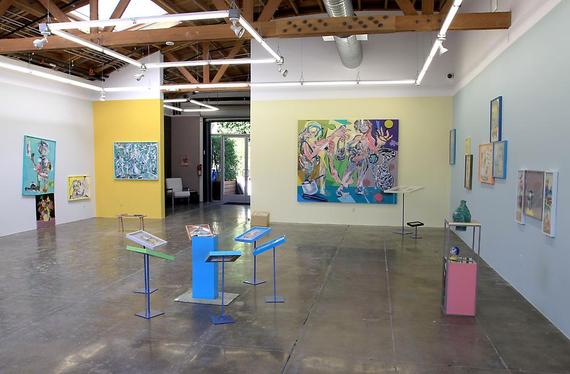
Installation shot, "Open to the Public." Image courtesy of Mark Moore Gallery.
The exhibition's color scheme is gaudy and disjunctive like the colors of a thrift store's multiplicity of objects. The Claytons' palette is skillfully mismatched in a tongue-in-cheek nod to the untrained chromatic discord of paintings found in secondhand stores. Even the gallery walls, frames, and pedestals are painted in off-key chintzy colors whose disharmony is strangely charismatic.
The Claytons' clashing colors are paralleled by incongruities of form that speak of the disjointed relationships between objects' previous and future owners, as well as the inevitable incoherence involved in thrift store scavenging: things are imperfect, shopworn; pieces are missing from sets that should be matched.
The brothers' subject matter dovetails into two foci: the patrons of Sun Thrift, and the objects within. In the Claytons' work, people are objectified and objects are personified. This is particularly apparent in the exhibition's flagship painting titled "Open to the Public." In this piece, an inchoate woman and man survey items for purchase. Both figures are unclothed, as if they had started their shopping spree with literally nothing. The woman holds up her own legs as if they were a pair of pants. Her eyes are bloodshot, her hair stringy and blue like a vinyl doll's. The man's violet eyes are desperate, yet his smiling blue mouth seems kind. The figures stand in an ambiguous space that, paradoxically, also appears to be a shelf off of which they are pulling items. Both figures' feet and ankles, especially the man's, diverge slightly with their upper legs at the point where the floor/shelf meets the background. Perhaps the figures are trying on different personalities, searching for objects that might ameliorate or augment their personae. In so doing, they become objectified for visual consumption, fractured under the potentially harsh gaze of others.
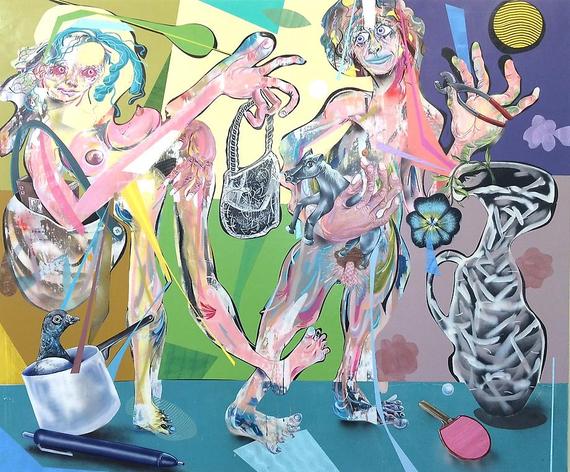
Clayton Brothers, "Open to the Public," 2014. Mixed media on canvas, 95 x 78 inches. Image courtesy of Mark Moore Gallery.
In "Sunday Sale," an elongated woman with weirdly shaped legs and pink and yellow fingernails holds an armful of flowers. A coat hanger hangs from her right hand. She has one shoe on and one off. Her figure is composed of three drawings, each inside a differently colored frame, stacked on top of one another in an off-kilter shape, like a tower of blocks about to topple over. Herself an agglomerate of three disparate identities, she wears a hat composed of a bundle of faces that might symbolize parts of her own personality, or people who owned the hat before her.
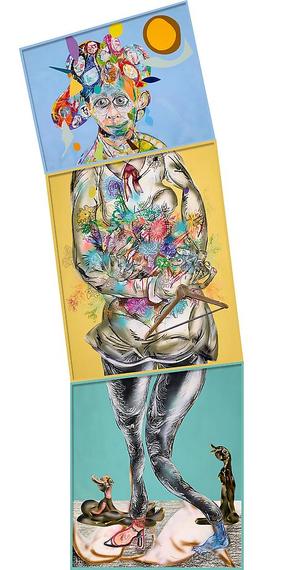
Clayton Brothers, "Sunday Sale," 2014. Mixed media on paper, 128 x 148 inches. Image courtesy of Mark Moore Gallery.
The idea of multiple personalities within a single person, as seen in "Sunday Sale," or people experimenting with identity, as in "Open to the Public," is a common thread in many of the Claytons' works. In buying an object second-hand, one gives it a new life; but from it, one may also receive a new life. Acquiring a certain important item, or even a seemingly unimportant one such as an article of clothing, and integrating it into one's life can influence one's way of thinking or personal direction. Obviously, thrift stores provide the impoverished with affordable necessities and even luxuries. For anyone, rich or poor, shopping at thrift stores can increase one's disposable income, allowing one to purchase and discard items more freely and at a faster rate than buying them new, thereby allowing more experimentation with outward manifestations of one's identity. At the same time, each item's provenance may consist of a long string of previous owners, each of which left invisible traces of use.
During their talk, the brothers mentioned their special interest in paintings that they found at Sun Thrift. In fact, Rob said, their primary interest is not so much in the store itself as in the broken narratives and aborted creativity that it contains. They think of unfinished paintings they found as "discarded creative efforts," which they seek to resuscitate by appropriating them into their own art.
"We think about it as this continuation that we were playing with, helping these objects or these people try to continue their language out to the art world, in a way," said Rob.
The Claytons see their own dichotomous collaboration with each other as corresponding to a communal collaboration among: the two of them, the artists that created the paintings that inspired them, and the total environment that is Sun Thrift and its patrons. However, their two-dimensional works are so unmistakably the Claytons' own creations that it's hard to see the communal influences or continued language within their paintings or drawings.
In their paintings, the Claytons project their own fantasies and ideas onto people and objects that they saw in the thrift store. The people and objects are thus seen only through the artists' eyes and hands, turning them into a cast of characters whose individuality has been displaced by that of the artists. Real collaboration between the Claytons and the personalities and objects that inspired them is more apparent in their assemblages, where their creativity and technical skill are no less evident, but strikingly underscored by intertwinement with actual articles from the store.
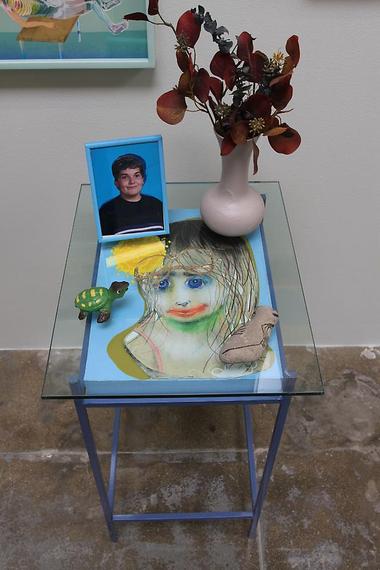
Clayton Brothers, "My Little Darling," 2014. Mixed media assemblage with mixed media on canvas, 44 x 16 x 20 inches. Image courtesy of Mark Moore Gallery. This assemblage, which merges found objects with the Claytons' own drawing, is particularly evocative.
Collaboration and continuation of broken narratives are most evident in the "Project Room," one of the most intriguing parts of the exhibition. The artists have turned the gallery's smaller room into an experimental, studio-like space that they plan to rearrange throughout the course of the exhibition in homage to the thrift store's constant state of flux. Rather than observing and recording, here the artists are actually accumulating things and actively putting them together like the other thrift store patrons. This room embodies the artists' ideas in their rawest form; here the brothers' personalities are most evident.
The centerpiece of the Project Room is a video projected onto the back of a shelf attached to a chair with a pole. At times, the video evokes a sense of creepiness, at times pathos, and occasionally a wry sense of humor augmented by clown music or funeral dirge soundtrack. Some of the scenes were shot with a camera inside a cart, moving very slowly down aisles. Others depict objects, store patrons reading, or children playing in the toy section. Behind the video, inside the shelf are cutouts and photos and plastic fruits. At the time of the opening, on the walls of the Project Room were various raw sources of inspiration such as dirty blank canvases, children's drawings, and black and white photos of signs seen at the store. In a particularly striking assemblage, a crutch holds up a shelf with an assortment of pathos-eliciting objects including a vase with dried flowers.
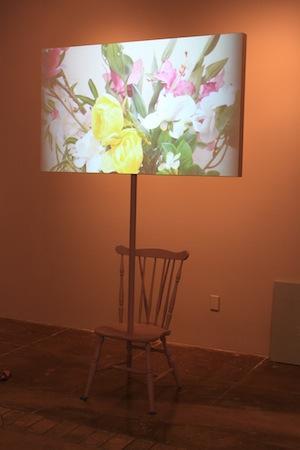
Clayton Brothers, "Dream," 2014. Video with memorabilia, 16 minutes, 7 seconds. Image courtesy of Mark Moore Gallery. The shelf-turned-projection screen attached to the chair is reminiscent of objects modified for uses alternative to their original purpose, common in secondhand stores.
Towards the end of their talk, the artists related several interesting anecdotes about people they met at the store: a man who called himself "Santa Claus;" a man who slept in chairs in the store; and a weird woman who followed behind Rob one day and ritualistically put everything he touched into her basket.
"It's interesting how you started out just going there and now you're really a part of it," Dambrot remarked. "You've really inserted yourselves into the fabric of this space."
It would be interesting to see more of their real experiences in the store, more of their place within the culture of the store and how they fit into it. For instance, although they spend a lot of time at the store, neither brother appears in the video. Likewise, neither is evident in any of their paintings or drawings. In fact, Rob said that when they were at the store, they tried to disappear.
"...As far as disappearing goes, that's when we would find ourselves drawn to the environment even more, and really start to understand the hierarchy of the way the customer and the employee and management would work with one another in order to get stuff sold, to find a new place for it," he said.
While the Claytons may feel that they disappear, they aren't invisible to those around them. They are as much a part of the hierarchy as anyone else. Hearing their anecdotes about interactions with other customers was fascinating. Why not use these interactions and more fully show their own status as a regular customer familiar with the store?
The point of view in their paintings is one of an imaginative observer. This is an interesting perspective, one that the artists execute with undeniable effectiveness. However, since they themselves are deeply engrained in the store's culture, they could easily use their position to bring more self-consciousness and social interaction into their two-dimensional works. Doing so would better realize their goals of collaboration, mending disjointed narratives, and bringing other artists' and craftsmen's ideas into the world. The world they create in their artwork is captivating, and it can only get richer as its sphere of influence expands.
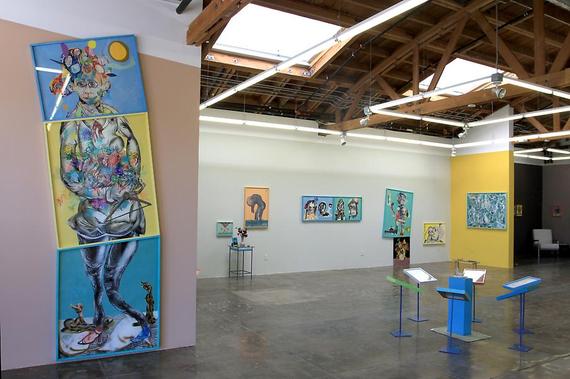
Installation shot, "Open to the Public." Image courtesy of Mark Moore Gallery.
"Open to the Public" is on view from August 16-September 27 at Mark Moore Gallery, 5790 Washington Blvd. Culver City, CA 90232. For more information regarding the exhibition, see markmooregallery.com